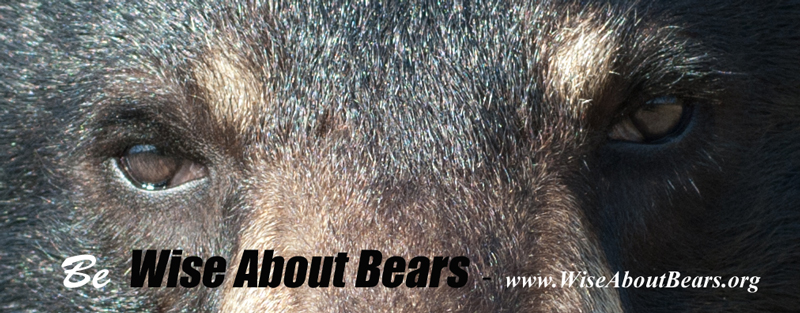A Black Bears Quest for Food
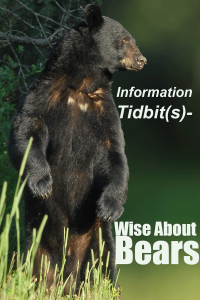 *Black bears are efficient berry-eaters, consuming up to 30,000 berries a day in a good year. They gather berries quickly, using their sensitive, mobile lips and swallowing them whole.
*Black bears are efficient berry-eaters, consuming up to 30,000 berries a day in a good year. They gather berries quickly, using their sensitive, mobile lips and swallowing them whole.
*Some seeds pass through the digestive tract unbroken and able to germinate, making black bears important seed dispersers. Each summer, they spread the seeds of their favorite berries all over their home ranges. For very large-seeded fruits like Canada plum (Prunus nigra), black bears are probably one of the few species that can disperse the seeds.
*Berries contain anti-oxidants, and the seeds of some species contain vitamin B-17, considered an anti-cancer compound by some scientists. Although cancer occurs in captive bears, it has never been reported in wild bears. – *Courtesy of Dr Lynn Rogers
Bears Annual Food Cycle – Chart courtesy of the Ontario Ministry of Natural Resources
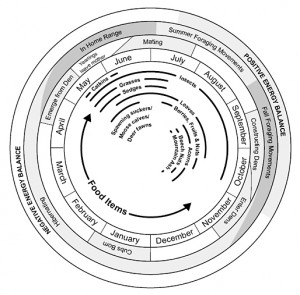 This chart illustrates the seasonal pattern of black bears. They emerge from their dens in the spring; live off of remaining body fat, eat grass, tree buds. Summer arrives, they feed on natural foods like berries, acorns and beech nuts in the summer and fall and hibernate during the winter. A bear’s life revolves around food.
This chart illustrates the seasonal pattern of black bears. They emerge from their dens in the spring; live off of remaining body fat, eat grass, tree buds. Summer arrives, they feed on natural foods like berries, acorns and beech nuts in the summer and fall and hibernate during the winter. A bear’s life revolves around food.
Unlike brown bears (grizzly bears) and polar bears, black bears are primarily inhabitants of forested areas where they are best able to meet their needs for cover, food, and security from
predators (including other bears).
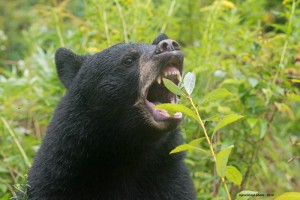 Black bears have well developed navigational abilities, though the specific mechanisms that they use are unknown. Bears use their navigational skills in summer and fall when they may migrate more than 100 km to blueberry patches, or to oak and beech stands. Apart from seasonal migrations, home ranges of adult female bears average 15 to 25 square km. Home ranges of adult males can be 10 times the size of female home ranges. Neither sex is believed to be territorial, and the home ranges of many bears can overlap.
Black bears have well developed navigational abilities, though the specific mechanisms that they use are unknown. Bears use their navigational skills in summer and fall when they may migrate more than 100 km to blueberry patches, or to oak and beech stands. Apart from seasonal migrations, home ranges of adult female bears average 15 to 25 square km. Home ranges of adult males can be 10 times the size of female home ranges. Neither sex is believed to be territorial, and the home ranges of many bears can overlap.
Foods Eaten
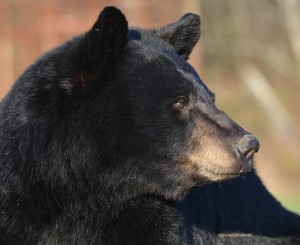 Bears have a keen sense of smell that enables them to locate food sources, including many that are not obvious to humans. Black bears are omnivores (they eat both plants and animals), but the bulk of their diet is plant material.
Bears have a keen sense of smell that enables them to locate food sources, including many that are not obvious to humans. Black bears are omnivores (they eat both plants and animals), but the bulk of their diet is plant material.
Generally, bears are opportunists. Their preferred foods are most abundant in uneven-aged mixed coniferous/deciduous forests that contain numerous shrub species. They consume a variety of food items as they become available throughout the year.
• In spring, bears feed on willow catkins, grasses, dandelions, clover, and aspen leaves. Leaves and flowers are preferred when they are highest in protein content (shortly after leaf burst or flowering), before the cell walls build up lignin and cellulose and become more difficult to digest. Important sources of protein in the spring may include newborn moose calves or deer fawns, or spawning suckers.
• In summer, ant colonies provide major protein sources, as do nests of bumblebees and wasps that are excavated and eaten. Berries and other soft fruits are eaten as they become available throughout the summer. These include fruits of various currants, wild sarsaparilla, dogwoods, strawberries, raspberries, pin and chokecherries, blueberries, and bristly sarsaparilla.
• In fall, hazelnuts, mountain ash, acorns and beechnuts are favoured foods.
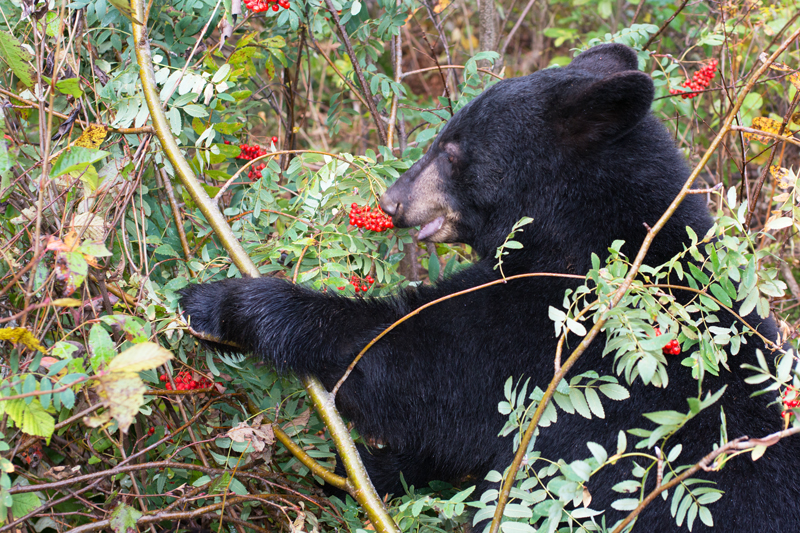
Food Availability
Items eaten in spring are generally predictable in timing of availability and do not vary greatly in abundance from one year to another. Nevertheless, many bears lose weight while
feeding on these foods. At best, bears will maintain their weight in the spring. Summer and fall food items vary greatly in timing of availability and in abundance from one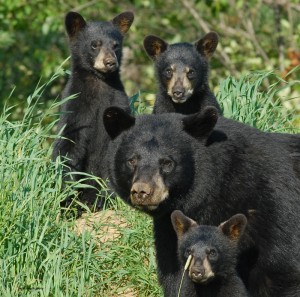 year to another. For example, blueberries can vary from less than 10 kg per hectare to more than 1000 kg per hectare. Bears can double their body weight in years when fruits are abundant. It is the abundance of summer and fall foods that has the greatest effect on survival and on the proportion of adult females that reproduce successfully.
year to another. For example, blueberries can vary from less than 10 kg per hectare to more than 1000 kg per hectare. Bears can double their body weight in years when fruits are abundant. It is the abundance of summer and fall foods that has the greatest effect on survival and on the proportion of adult females that reproduce successfully.
The potential for nuisance bear activity increases in years when berry crops fail and the animals search for alternate food sources. The behaviour may also be apparent the following spring when animals emerge from their dens in poor condition. Survival of the current year’s cubs can be low following berry crop failure, and few females will produce cubs the following year.
Credit text – Ontario Ministry of Natural Resources – by L.J. Landriault, M.E. Obbard and W.J. Rettie
Photos – Mike McIntosh

